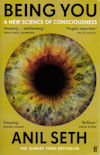After over twenty years researching the brain, world-renowned neuroscientist Anil Seth puts forward a radical new theory of consciousness and self. His unique theory of what it means to ‘be you’ challenges our understanding of perception and reality and it turns what you thought you knew about yourself on its head.
I confess that I have a problem with the problem of consciousness: most descriptions implicitly assume that consciousness itself is a well-defined concept. But I’ve never really come across a precise definition that could be a satisfactory starting point for examining it. Wikipedia starts off with “awareness of internal and external existence”; okay, but what is “awareness” in this context? Many definitions assume it is a human property, which begs the question of possible animal consciousness. And so on.
In this book on state of the art studies of consciousness, Seth also doesn’t give a precise definition. He is tackling the issue from a somewhat different direction, and describes consciousness as “something that it is like to be you”. Then we can allow for the possibility of animal consciousness: there might be something it is like to be a dog, or a bat, or a mouse, or an octopus, but presumably there is nothing it is like to be a rock, or a river, or a car. Is there something it is like to be a tree, or a carrot, or a bacterium? Could there be something it is like to be a robot?
I’m still struggling, though: I’m not really sure what it specifically is like to be me, because I’ve never been anything else, so have nothing to compare it with. Maybe I should just go with “something that it is like to be”?
Lack or precise definitions aside, this is an excellent and thought-provoking book. Seth links consciousness to sensing and acting in the world, at many different levels. Essentially, the brain “hallucinates” different possibilities of what is happening, and uses what we sense to choose the best possibility, which can change as we get more sensory input (such as from the world changing, or from us changing things in the world, including our own position in it). This is accompanied by descriptions of a variety of interesting experiments, and leads to possible criteria for detecting consciousness in patients in comas.
There is lots of great detail here to back up the various claims, and the model explains senses, actions, emotions, and more. Seth uses this model to argue that machines (robots, computers) can never be conscious, that only “wet” organisms have the essential grounded linkages between their hallucinations, senses, and bodily processes, to be fully conscious. I’m not sure I agree with this conclusion, but it is certainly food for thought.
